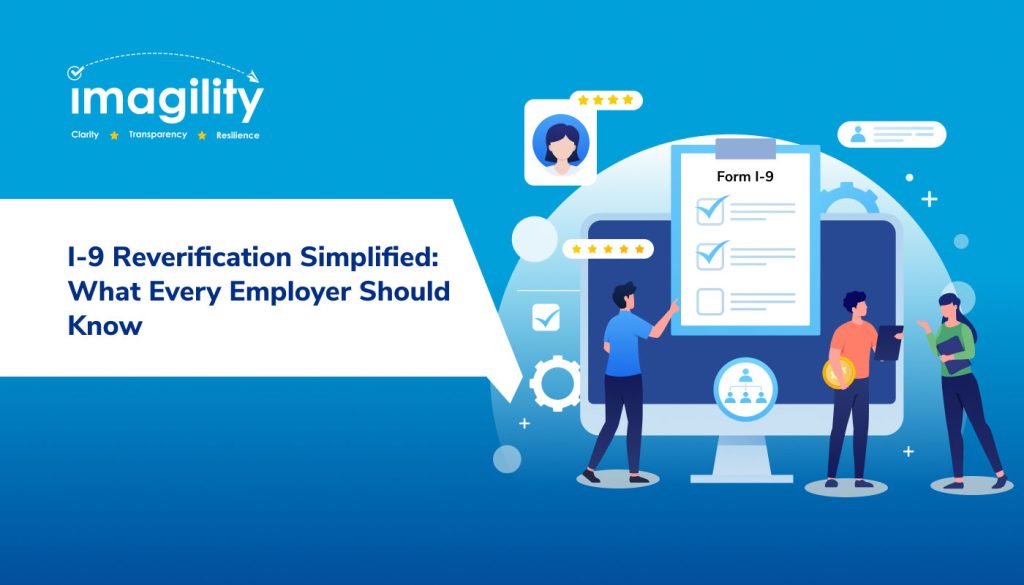Table of Contents
Understanding I-9 Reverification
Common Scenarios Requiring Reverification
Best Practices to Follow for Simplified I9 Reverification
Conclusion
For every employer in the United States, adhering to immigration laws and regulations is crucial when hiring and maintaining a diverse workforce. The I-9 form, issued by the U.S. Citizenship and Immigration Services (USCIS), is a fundamental document used to verify the identity and employment eligibility of individuals working in the country.
As an employer, it’s essential to understand the process of I-9 reverification and how to navigate it efficiently. In this blog, we’ll break down the complexities of I-9 reverification, offering insights and guidance to ensure your business remains compliant.
Understanding I-9 Reverification
The I-9 form, officially known as the Employment Eligibility Verification Form, is used to verify U.S. citizens’ and noncitizens’ identity and employment authorization. When a new employee is hired, the employee completes Section 1 of the form. Simultaneously, the employer verifies the employee’s eligibility to work by reviewing acceptable documents, such as a U.S. passport, driver’s license, Social Security card, or other approved documents, as outlined in the I-9 instructions.
However, in some cases, an employee’s work authorization might expire. This is where I-9 reverification comes into play. Reverification involves updating Section 3 of the I-9 form to document that the employee’s work authorization has been extended or changed. It’s essential to note that not all employees require reverification—only those whose employment authorization documents (EADs) have a specified end date.
Common Scenarios Requiring Reverification
Below are some common scenarios for I-9 reverification. Let’s take a closer look.
- Temporary Work Authorization
Some employees may have temporary work authorization due to visa limitations or other circumstances. In these cases, when the work authorization expires, it’s necessary to reverify the employee’s eligibility to work.
- Status Changes
If an employee’s immigration status changes, such as becoming a U.S. permanent resident or obtaining a different type of work visa, reverification is needed to ensure their continued eligibility.
- Employment Authorization Document (EAD) Renewal
Employees who hold an EAD often need to renew it before it expires. Once renewed, their work authorization status changes, warranting reverification.
Best Practices to Follow for Simplified I9 Reverification
I-9 reverification might sound intricate, but with a structured approach and following best practices, employers can navigate the process with ease and accuracy.
- Maintain a Tracking System
Keep a meticulous record of your employees’ work authorization expiration dates. Set up reminders well in advance to initiate the reverification process promptly.
- Notify the Employee
Inform the employee at least 90 days before their work authorization expires. This provides them ample time to gather the necessary documentation and prevent any gaps in their employment eligibility.
- Documents Required
Depending on the situation, the employee may need to provide updated documents, such as a renewed EAD or updated permanent resident card. Ensure you’re using the most up-to-date list of acceptable documents provided in the I-9 instructions.
- Prevent Unlawful Practices
Refrain from asking employees for specific documents beyond what is required by the I-9 form. Additionally, never request documents based on stereotypes or assumptions about an employee’s citizenship or immigration status.
- Training for HR Personnel
Ensure that your human resources personnel are well-trained in the I-9 process, including reverification. This helps prevent errors and reduces the risk of unintentional discrimination.
- Employ an AI-powered Technology Solution
Implementing a software management system such as Imagility I-9 compliance management can significantly simplify your I-9 compliance processes. This comprehensive service guides the employer seamlessly through every stage of the reverification process, effortlessly monitors expiration dates, and promptly informs both the employee and the employer about upcoming reverification requirements.
Conclusion
Navigating the I-9 reverification process is essential to maintaining a lawful and diverse workforce in the United States. By understanding the scenarios that require reverification, following a simplified process, and employing a technology solution like Imagility I9 compliance management, employers can ensure compliance with immigration laws and avoid unnecessary complications and hefty penalties.
Remember that accurate documentation, timely communication with employees, and a commitment to nondiscrimination are key elements in successfully managing I-9 reverification.









